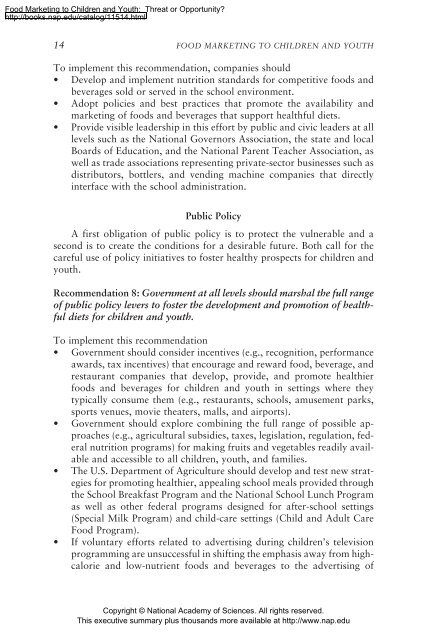Food marketing to children and youth
Food marketing to children and youth
Food marketing to children and youth
You also want an ePaper? Increase the reach of your titles
YUMPU automatically turns print PDFs into web optimized ePapers that Google loves.
<strong>Food</strong> Marketing <strong>to</strong> Children <strong>and</strong> Youth: Threat or Opportunity?http://books.nap.edu/catalog/11514.html14 FOOD MARKETING TO CHILDREN AND YOUTHTo implement this recommendation, companies should• Develop <strong>and</strong> implement nutrition st<strong>and</strong>ards for competitive foods <strong>and</strong>beverages sold or served in the school environment.• Adopt policies <strong>and</strong> best practices that promote the availability <strong>and</strong><strong>marketing</strong> of foods <strong>and</strong> beverages that support healthful diets.• Provide visible leadership in this effort by public <strong>and</strong> civic leaders at alllevels such as the National Governors Association, the state <strong>and</strong> localBoards of Education, <strong>and</strong> the National Parent Teacher Association, aswell as trade associations representing private-sec<strong>to</strong>r businesses such asdistribu<strong>to</strong>rs, bottlers, <strong>and</strong> vending machine companies that directlyinterface with the school administration.Public PolicyA first obligation of public policy is <strong>to</strong> protect the vulnerable <strong>and</strong> asecond is <strong>to</strong> create the conditions for a desirable future. Both call for thecareful use of policy initiatives <strong>to</strong> foster healthy prospects for <strong>children</strong> <strong>and</strong><strong>youth</strong>.Recommendation 8: Government at all levels should marshal the full rangeof public policy levers <strong>to</strong> foster the development <strong>and</strong> promotion of healthfuldiets for <strong>children</strong> <strong>and</strong> <strong>youth</strong>.To implement this recommendation• Government should consider incentives (e.g., recognition, performanceawards, tax incentives) that encourage <strong>and</strong> reward food, beverage, <strong>and</strong>restaurant companies that develop, provide, <strong>and</strong> promote healthierfoods <strong>and</strong> beverages for <strong>children</strong> <strong>and</strong> <strong>youth</strong> in settings where theytypically consume them (e.g., restaurants, schools, amusement parks,sports venues, movie theaters, malls, <strong>and</strong> airports).• Government should explore combining the full range of possible approaches(e.g., agricultural subsidies, taxes, legislation, regulation, federalnutrition programs) for making fruits <strong>and</strong> vegetables readily available<strong>and</strong> accessible <strong>to</strong> all <strong>children</strong>, <strong>youth</strong>, <strong>and</strong> families.• The U.S. Department of Agriculture should develop <strong>and</strong> test new strategiesfor promoting healthier, appealing school meals provided throughthe School Breakfast Program <strong>and</strong> the National School Lunch Programas well as other federal programs designed for after-school settings(Special Milk Program) <strong>and</strong> child-care settings (Child <strong>and</strong> Adult Care<strong>Food</strong> Program).• If voluntary efforts related <strong>to</strong> advertising during <strong>children</strong>’s televisionprogramming are unsuccessful in shifting the emphasis away from highcalorie<strong>and</strong> low-nutrient foods <strong>and</strong> beverages <strong>to</strong> the advertising ofCopyright © National Academy of Sciences. All rights reserved.This executive summary plus thous<strong>and</strong>s more available at http://www.nap.edu
















